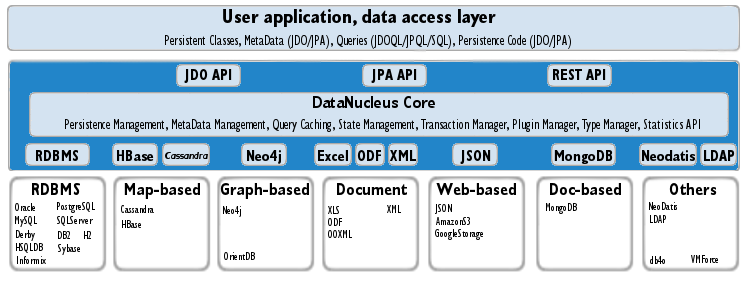
|

|

|

|

|

|

|
|
| DataNucleus AccessPlatform 4.1 Documentation |
|
DataNucleus AccessPlatform implements the JDO and JPA specifications. These specifications define how Java classes can be persisted to a datastore and how they can be queried. By choosing AccessPlatform you can select which of these APIs you feel most comfortable with. Time for you to get started and use AccessPlatform!
You now have the necessary components to start investigating use of DataNucleus.
Decide which persistence API you want to use. If you're not familiar with these APIs then the next thing to do is to learn about JDO and JPA, or alternatively REST. You need to understand the basic concepts involved. There is plenty of reading on the internet, starting with the JDO or JPA specifications of course.
The best thing to do after some reading is to try the JDO Tutorial (for RDBMS, HBase, MongoDB, Neo4j, Cassandra, ODF, Excel) or try the JPA Tutorial (for RDBMS, HBase, MongoDB, Neo4j, Cassandra, ODF, Excel). These explain the basic steps of applying JDO/JPA (and DataNucleus) to your own application and provides a link to download the source code for the Tutorial. Please download it and start up your development environment with the Tutorial classes and files. Once you have completed the Tutorial you're in a position to apply DataNucleus JDO/JPA to your own application, and start benefiting from what it offers.

There are some key points to bear in mind when starting using JDO/JPA for java persistence.